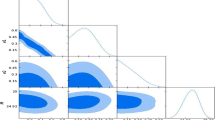Abstract
An attempt to produce a continuous creation theory by adapting the Brans-Dicke theory is described. The universe is seen to be created out of self-contained gravitational, scalar, and matter fields. However, the solution of the one-body problem reveals unsatisfactory characteristics of the theory, and in particular the principle of equivalence is severely violated. A second theory is described which retains the attractive features of the first theory and which does not fall foul of its objections. There do exist empirical tests for the theory which are described and which will require further examination. In the limit this theory approaches general relativity in every respect.
Similar content being viewed by others
Abbreviations
- □2 gf :
-
the invariant d'Alembertian
- t 0 :
-
Hubble time
- H :
-
Hubble's constant
- φ :
-
scalar field
- λ :
-
coupling constant
- T Mμν :
-
energy-momentum tensor of matter and nongravitational energy, and nonscalar field energy
- T Mφν :
-
energy-momentum tensor of scalar field energy
- T Mμν :
-
covariant form
- T M μν :
-
contravariant form
- T M μ ν :
-
mixed form
- T M λ λ :
-
T M σ σ trace
- T M μ ν;μ :
-
covariant differentiation
- \(\dot \phi ;^v \) :
-
contravariant differentiation
- T μν :
-
Ricci tensor
- R :
-
curvature scalar (in tensorial equations)
- δμ ν :
-
Kronecker symbol
- θ(φ) :
-
a function ofφ used in the text
- ϱ :
-
density
- p :
-
pressure
- gμν :
-
the metric tensor
- R(t) :
-
scale factor (in cosmological equations)
- U μ :
-
the fluid 4-velocity (covariant)
- U μ :
-
the fluid 4-velocity (contravariant)
- \(\dot \phi \dot R\) :
-
functions differentiated once with respect to time (\(\ddot \phi \ddot R\), differenciated twice)
- k :
-
the Robertson-Walker curvature constant=+1, 0, or −1
- ∝ :
-
proportional to
- g :
-
gravitational coefficient
- ξ :
-
parameter
- θ :
-
angle of deflection, or coordinate
- ψ :
-
angle of precession or coordinate
- ζ :
-
angle of precession
- G v :
-
the force density
- δ3(ϰ − ϰ n (t)):
-
the Dirac delta function
- τ :
-
proper time
- K :
-
an unknown function definingG
- Δϕ :
-
total angle of deflection
- r 0 :
-
minimum radius of approach of a light ray grazing the sun
References
Roxburgh, I. W. (1977). Large number hypothesis and continuous creation cosmologies,Nature,268, 504.
Steigman G. (1976). Particle creation and Dirac's large numbers hypothesis,Nature,261, 479.
Canuto, V., Adams, P. J., Hsieh, S. H., and Tsiang, E. (1976). Matters arising-Particle creation and Dirac's large numbers hypothesis,Nature,264, 485.
Dirac, P. A. M. (1974). Cosmological models and the large numbers hypothesis,Proc. R. Soc. London Ser. A,338, 439–446.
Weinberg, S. (1972).Gravitation and Cosmology. Wiley, New York.
Author information
Authors and Affiliations
Rights and permissions
About this article
Cite this article
Barber, G.A. On two “self-creation” cosmologies. Gen Relat Gravit 14, 117–136 (1982). https://doi.org/10.1007/BF00756918
Received:
Issue Date:
DOI: https://doi.org/10.1007/BF00756918




